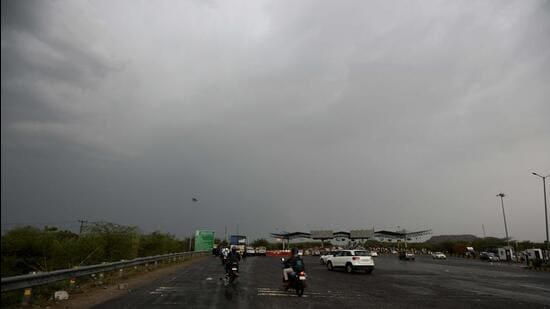Western disturbance combined with monsoon trough causing rain spells: IMD
The city witnessed a sudden thunderstorm and rain on Monday evening, resulting in water logging on roads in a few places, said officials
The city witnessed a sudden thunderstorm and rain on Monday evening, resulting in water logging on roads in a few places, said officials. Though the rain did cause a minor disruption in traffic for around 15 minutes on some stretches, it did not result in the uprooting of trees or damage to infrastructure.

While the India Meteorological Department (IMD) on Sunday had forecast that moderate rainfall was likely to take place at isolated places in Haryana during the next 24 hours, Gurugram recorded 7mm of rainfall on Monday--the most rain in the entire state.
Additional CEO (environment), Gurugram Metropolitan Development Authority, Subhash Yadav said that no incident of any tree being uprooted was reported from any part of Gurugram after Monday evening’s rain. “Everything remained normal as the wind was probably not strong enough and the downpour lasted only for a few minutes on Monday,” he added.
Manmohan Singh, the director of IMD’s regional centre in Chandigarh, said that a monsoon trough (also called the east-west trough) passing through Haryana resulted in a low-pressure area on the entire northern belt including Haryana, due to which the region witnessed rain on Sunday and Monday.
“Some areas in Haryana also witnessed strong winds. This system started circulating on Sunday,” he said.
Singh said that on June 2, Gurugram and other parts of Haryana may witness light to moderate rainfall along with thunderstorms due to a western disturbance. A western disturbance refers to an area of “disturbed” or reduced air pressure, moving from the west to the east, carrying with it moisture associated with rainfall, snowfall and fog in northern India.
“This east-west trough will also persist for the next two or three days,” the director said.
As per the senior IMD official, the rain will bring relief from the heat as well. Gurugram’s maximum temperature will hover between 38 degrees Celsius and 42 degrees Celsius and will not rise further for the next one week.
Officials said Gurugram’s maximum temperature was 40.5 degrees Celsius on Monday, which was 1.2 degrees less than Sunday.
According to data from the Central Pollution Control Board, Gurugram recorded “moderate” air quality, with an Air Quality Index (AQI) reading of 200 on Monday--an improvement over Sunday’s AQI reading of 254 in the “poor” category.
An AQI reading between zero and 50 is considered “good”, 51 and 100 “satisfactory”, 101 and 200 “moderate”, 201 and 300 “poor”, 301 and 400 “very poor”, and 401 and 500 “severe”.
Manmohan Singh, the director of IMD’s regional centre in Chandigarh, said that a monsoon trough (also called the east-west trough) passing through Haryana resulted in a low-pressure area on the entire northern belt including Haryana, due to which the region witnessed rain on Sunday and Monday.
“Some areas in Haryana also witnessed strong winds. This system started on Sunday,” he said.
Singh said that on June 2, Gurugram and other parts of Haryana may witness light to moderate rainfall along with thunderstorms due to a western disturbance. A western disturbance refers to an area of “disturbed” or reduced air pressure, moving from the west to the east, carrying with it moisture associated with rainfall, snowfall and fog in northern India.
“This east-west trough will also persist for the next two or three days,” the director said.
As per the senior IMD official, the rain will bring relief from the heat as well. Gurugram’s maximum temperature will hover between 38 degrees Celsius and 42 degrees Celsius and will not rise further for the next one week.
Officials said Gurugram’s maximum temperature was 40.5 degrees Celsius on Monday, which was 1.2 degrees less than recorded on Sunday.
According to data from the Central Pollution Control Board, Gurugram recorded “moderate” air quality, with an Air Quality Index (AQI) reading of 200 on Monday--an improvement over Sunday’s AQI reading of 254 in the “poor” category.
An AQI reading between zero and 50 is considered “good”, 51 and 100 “satisfactory”, 101 and 200 “moderate”, 201 and 300 “poor”, 301 and 400 “very poor”, and 401 and 500 “severe”.
Stay updated with all the Breaking News and Latest News from Mumbai. Click here for comprehensive coverage of top Cities including Bengaluru, Delhi, Hyderabad, and more across India along with Stay informed on the latest happenings in World News.
Stay updated with all the Breaking News and Latest News from Mumbai. Click here for comprehensive coverage of top Cities including Bengaluru, Delhi, Hyderabad, and more across India along with Stay informed on the latest happenings in World News.





